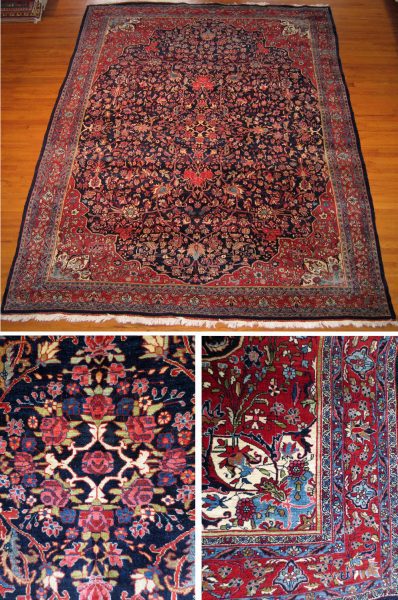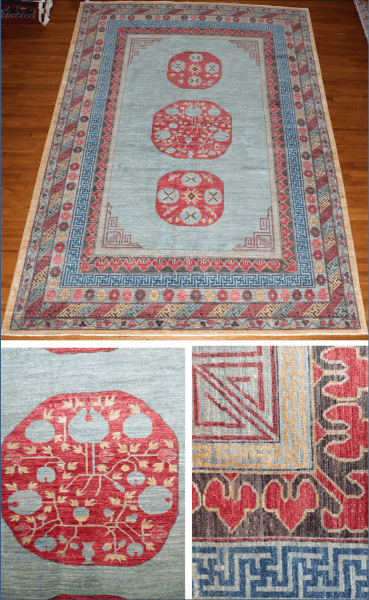Window Watch Beautiful Antique Bijar & Synergetic Khotan
Posted on February 12th, 2015 by Joshua Kebabian
WINDOW LEFT
Displayed in WINDOW LEFT is a lovely Antique Persian Bijar measuring 8.9 by 11.8. This piece was hand-knotted in western Persia by Kurdish women, using handspun, vegetally dyed, local mountain sheep wool.
In spite of their “coarse” weave, no other type exceeded the beauty or durability of the Persian Bijars made during the period of 1923-30. The extensive use of various Persian motifs is unequalled. Also, central to the artist’s design in this piece was the use of the lovely French rose cluster design, which originated from French tapestries.
The artist uses a radiant rose cluster for the central medallion and thoughtfully integrates the rose “bouquets” into key sections of the navy field. The four outer ivory and slate blue quadrants brighten the piece, stylishly directing the eye to the lavish inner field overflowing with a wonderful assortment of stylized flowers. Peacefully grounding the gorgeous Bijar is a quiet and sophisticated main border.
An artist knows that “Great things are done by a series of small things brought together.” Vincent Van Gogh. This gorgeous Bijar is a work of art that will not only please the eye with its beauty, but satisfy the mind with the extensive and thoughtful use of many “small things”.
WINDOW RIGHT
The striking Afghan Khotan hanging in WINDOW RIGHT measuring 9 x 12.7 was hand-knotted in northern Afghanistan by 4 Hazara women over a period of 6-7 months using handspun vegetally dyed local wool.
The Khotan design originates in East Turkestan, located on the Silk Road in close proximity to both China & Persia. The Khotan incorporates motifs from both regions. This stellar piece is an Antique reproduction.
The 6 guard borders include 2 swastika borders, a “T” or “thunder” border (Chinese influence) and 2 charming floral chains plus the trefoil (Persian influence). The two cultures framing the intriguing Khotan bring a happy synergy. “Alone we can do so little; together we can do so much.” Helen Keller.
The central medallion contains the classic Khotan motif, the pomegranate, which represents life and abundance. In this primitive depiction which brings a carefree vibe, the pomegranate is portrayed as a shrub
The abrash (variation of color due to different dye lots) adds texture and softens the piece. The artist’s palette of madder red and charcoal draws in warmth while the breath-taking inner field of light blue brings in air and a freshness.
This exceptional piece which combines strong lines and gentle, happy flowers brings a fresh, complex and happy vibe to a space – where thinking and smiles may live together harmoniously. 🙂
Oriental Rugs: A Complete Guide Charles W. Jacobsen
Oriental Rugs: Antique and Modern Walter A. Hawley



